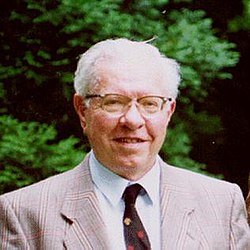Fred Hoyle
Sir Fred Hoyle FRS (24 June 1915 – 20 August 2001) was an English astronomer noted primarily for the theory of stellar nucleosynthesis, but also for his often controversial stances on other scientific matters—in particular his rejection of the "Big Bang" theory, a term coined by him on BBC radio, and his promotion of panspermia as the origin of life on Earth. While Hoyle is well-regarded for his works on nucleosynthesis and science popularisation, his career is also noted for the controversial positions he held on a wide range of scientific issues, often in direct opposition to the prevailing theories supported by the majority of the scientific community. He spent most of his working life at the Institute of Astronomy at Cambridge and served as its director for six years. He was a writer of science fiction, and co-authored twelve books with his son, Geoffrey Hoyle.
Hoyle was born near Bingley in Gilstead, West Riding of Yorkshire, England. His father, Ben Hoyle, worked in the wool trade in Bradford. His mother, Mabel Pickard, had studied music at the Royal College of Music in London. Hoyle was educated at Bingley Grammar School and read mathematics at Emmanuel College, Cambridge. In late 1940, Hoyle left Cambridge to go to Portsmouth to work for the Admiralty on radar research, for example devising a method to get the altitude of the incoming aeroplanes. He was also put in charge of countermeasures against the radar guided guns found on the Graf Spee. Britain's radar project employed more personnel than the Manhattan project, and was probably the inspiration for the large British project in The Black Cloud. Two key colleagues in this war work were Hermann Bondi and Thomas Gold, and the three had many and deep discussions on cosmology. The radar work paid for a couple of trips to North America, where he took full advantage to visit astronomers. On one trip he learned about supernovae at Caltech and Mt. Palomar and, in Canada, the nuclear physics of plutonium implosion and explosion, noticed some similarity between the two and started thinking about supernova nucleosynthesis. He had an intuition at the time "I will make a name for myself if this works out." Eventually (1954) his prescient and ground breaking paper came out. He also formed a group at Cambridge exploring Stellar nucleosynthesis in ordinary stars and was bothered by the paucity of stellar carbon production in existing models. He noticed that one of the existing processes would be made a billion times more productive if the carbon-12 nucleus had a resonance at 7.7 MeV, but the nuclear physicists did not list such a one. On another trip he visited the world class nuclear physics group at Caltech, spending a few months of sabbatical there and persuaded them against their considerable scepticism to look for and find the Hoyle state in carbon-12, from which developed a full theory of stellar nucleosynthesis, co-authored by Hoyle with some members of the Caltech group.
...
Wikipedia

